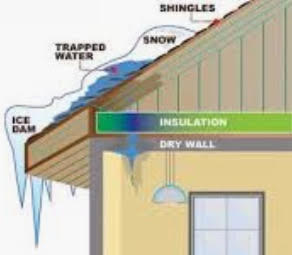
Ice damning occurs frequently in the northern hemisphere during the winter months when ice and snow combine to form a nasty little party on the roof of an unsuspecting house. While this, fortunately, doesn’t happen on every roof, it does wreak havoc on a relatively high percentage of homes.
It occurs when heat rises from the primary living area through the attic and melts the snow which is innocently sitting on the roof. As the snow melts, it runs down the shingles. However, the snow at the eaves, or bottom of the roof, is not subject to the same melting because it does not have the same heat rising to melt it.
As a result, the melting snow runs to the edge of the roof, cools down and refreezes, and combines with the snow at the edge of the roof. This forms an icy barrier that eliminates the chance for any water to run off the roof.
This snow/ice barrier forms a nasty but effective damn that forces further melting snow to stop and back up under the shingles. Asphalt shingles are not designed to seal the water out of a house. They are designed to shed water off the roof. When the ice damn forces water to back up, the shingles are simply not engineered to stop it from entering the house’s envelope.
Houses with low slope roofs are more susceptible to this phenomenon due to the lower rate of runoff. They also typically have more overhang than steep roofs and provide more of a surface for ice damns.
There are some things homeowners can do to help reduce the possibility of this happening. The best thing is to make sure the attic has proper insulation to reduce the possibility of heat melting the snow on the roof. In some jurisdictions, new building codes call for an insulating value of R 50 in attics, which is about 15 inches of blown cellulose insulation.
It is also helpful to ensure the attic has proper ventilation. Adequate soffit and ridge vents help to keep the attic dry in the event that some water does leak in under the shingles.
Another effective step is to install ice and water shield on the roof sheathing for the first 35 feet. This is a highly durable material that sticks to the sheathing under the shingles and prevents stopped up water from going any further into the building envelope. It is thicker and tougher than simple tar paper. This is easiest to put on when installing a new roof. However, if the current roof has severe problems with water seepage and the roof sheathing is rotted, this may be a necessary step.
Attempts to put heat tapes on the bottom part of the roof areas to prevent this ice buildup are well intentioned, but sometimes cause more problems than they solve.
